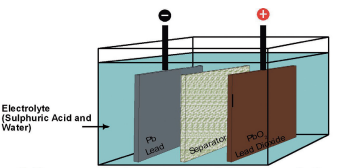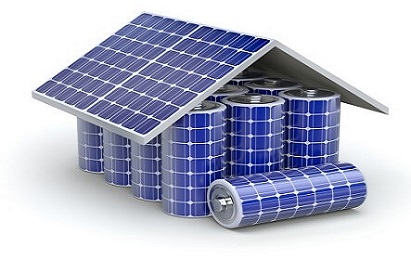In Part 1 of the series, we tackled lithium-ion batteries. Part 2 goes on to discuss lead acid batteries, and summarises a comparison of both. Consider this comparison of these batteries to help you in selecting the correct type of battery for your home or business…
Lead Acid Batteries
Lead acid batteries are large capacity rechargeable batteries. These batteries are used in automobiles, electric vehicles, boats, solar systems, and uninterruptible power supplies (UPS). They are composed of several individual cells that contain layers of lead alloy plates which are immersed in an electrolyte solution. Metals such as antimony, calcium, tin, selenium are sometimes included to provide more mechanical strength and enhance electrical properties. The electrolyte solution is made up of 35% sulfuric acid and 65% water, and energy is produced due to the chemical reactions that occurs between the sulfuric acid and the lead plates.
How Does a Lead Acid Battery Work?
A lead acid battery is composed of two chemically dissimilar lead-based plates in a dilute sulphuric acid solution. The positive plate will contain lead dioxide (PbO2) whilst the negative plate will consist of pure lead in a spongy form.
As the battery discharges, sulphite ions present in the electrolyte will interact with the negative and positive plates and this leads to the formation of lead sulphate on both. A reduction in the specific gravity in proportion to the charge delivered is experienced when there is a loss of sulphite ions in the electrolyte. As the battery charges again, the electric current will convert the plates back to a charged state, and the sulphate will be converted back to sulphuric acid. The specific gravity of the electrolyte will subsequently increase again as a result.

What are the Different Types of Lead Acid Batteries?
Vented lead acid batteries allow for gas to escape the battery without any positive pressure building up in the cells. These batteries can be topped up if required and are more tolerant to overcharging and high temperature when in operation. The free electrolytes present also assists in the cooling of the battery.
Sealed lead acid batteries are maintenance-free batteries that are sealed with a pressure release valve. The presence of a pressure release valve will limit the escape of the gas to release the pressure. The electrolyte present in the battery is immobilised to prevent spillage and facilitate gas recombination. These batteries are smaller in size and are installed in locations where ventilation is insufficient. These batteries are more susceptible to failure if operating at a higher temperature when compared to vented lead acid batteries.
Lithium-Ion vs Lead Acid Batteries
Cost
Lead acid batteries outperform lithium-ion batteries when comparing the cost of the batteries to each other. Although lead acid batteries are cheaper, the lifetime value of lithium-ion batteries evens the cost out and mostly outperforms lead acid in terms of cost over time.
Capacity
The capacity of the battery is the amount of energy that can be stored and eventually discharged by the battery. Lithium-ion batteries have a significantly higher energy density than lead acid batteries thus allowing them to store more energy in the same physical space.
Depth of Discharge
The depth of discharge of a battery represents the percentage of the battery that can be safely drained without damaging the battery. It is normal to use 85% or more of a lithium-ion battery’s total capacity in a single cycle, whilst lead acid batteries should not be discharged past roughly 50%. This will result in negatively impacting the lifetime of the battery.
Efficiency
A battery that has a higher efficiency will charge faster and have a higher effective battery capacity. Lithium-ion batteries are 95% or more efficient whilst lead acid batteries are closer to 80-85%.
Lifespan
Batteries degrade over time and become less effective as they age. Lithium-ion batteries have a longer effective lifespan, as they last several times the number of cycles when compared to lead acid batteries.
Should you install a lead acid battery or a lithium-ion battery?
Both lead acid and lithium-ion batteries are effective options for battery backup systems. Lithium-ion batteries are the preferred option despite the higher cost as it has a longer lifetime, higher efficiency, and higher energy density. Lead acid batteries will be a better option for an off gird solar installation if it is not used frequently.
The table below summarises the advantages that Lithium-Ion batteries have over Lead Acid.
As seen above, the lithium-ion battery technology is superior when compared to lead acid, because of its reliability, capacity, depth of charge and efficiency. Lead acid batteries are often used in small off-grid storage systems that are not used regularly because of it being cheaper in cost.
Buy your batteries online. Shop the Magnet Store now!
Sources:
https://www.lightingglobal.org/wp-content/uploads/2019/06/Lithium-Ion_TechNote-2019_update.pdf
https://news.energysage.com/lithium-ion-vs-lead-acid-batteries/
https://www.battery.co.za/wp-content/themes/battery/dl/IndustrialBatteriesTypesSelection.pdf


